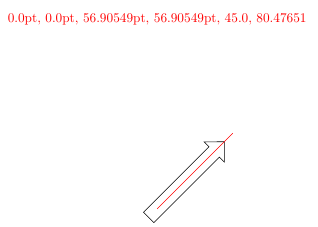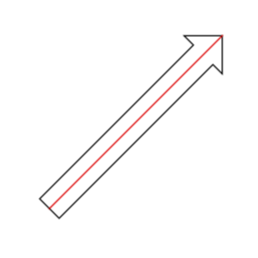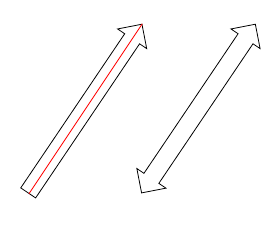|
Ich möchte ein Kommando erstellen, dass es erlaubt einen Dazu habe ich Winkel und Abstand der Koordinaten berechnet. Der Winkel ist schonmal der richtige, die Länge des Pfeils scheint nahezu die Richtige zu sein. Aber mit der Position des Pfeils stimmt etwas nicht. \documentclass[margin=5mm]{standalone} \usepackage{amsmath, amssymb} \usepackage{tikz} \usetikzlibrary{shapes} \begin{document} \tikzset{Pfeil/.style={ single arrow, draw, minimum width=5ex, %minimum height=13ex, inner sep=1ex, %text height=1ex, %text depth=0ex, single arrow head extend=1ex }} \begin{tikzpicture} \coordinate (A) at (0,0); \coordinate (B) at (2,2); % ... \path (A); \pgfgetlastxy{\Ax}{\Ay} \path (B); \pgfgetlastxy{\Bx}{\By} %\pgfmathsetmacro{\Length}{veclen(\Ax,\By)} \pgfmathsetmacro{\Length}{sqrt((\By-\Ay)^2+(\Bx-\Ax)^2)} \pgfmathsetmacro{\Angle}{atan((\By-\Ay)/(\Bx-\Ax))} \path[] (A) node[ Pfeil, rotate=\Angle, xshift=1*0.5*\Bx, yshift=0*0.5*\By, minimum height=1.0*\Length, %minimum width=1.0*\Bx, ] {}; % Kontrolle \draw[red] (A) -- (B) ; \node[red] at (0,5) {\Ax, \Ay, \Bx, \By, \Angle, \Length}; \end{tikzpicture} \end{document} |
|
Verwandt mit meiner Antwort auf die verlinkte Frage und teilweise basierend auf https://tex.stackexchange.com/a/432147/121799. Wenn Du \documentclass[margin=5mm]{standalone} \usepackage{tikz} \usetikzlibrary{shapes.arrows,calc} \tikzset{Pfeil/.style=% {to path={let \p1 = ($(\tikztotarget)-(\tikztostart)$), \n1 = {int(mod(scalar(atan2(\y1,\x1))+360, 360))}, % calculate angle in range [0,360) \n2 = {veclen(\x1,\y1)} in \pgfextra{\typeout{\n1,\n2,\x1,\y1}} (\tikztotarget) node[draw,single arrow, minimum height=\n2-\pgflinewidth, % minimum width=5ex, %minimum height=13ex, inner sep=1ex, %text height=1ex, %text depth=0ex, single arrow head extend=1ex, rotate=\n1, % not shape border rotate, because that for some reason didn't work anchor=tip, % anchor=tip added, pos=0.5 removed ]{} }}} \begin{document} \begin{tikzpicture} \coordinate (A) at (0,0); \coordinate (B) at (2,2); \draw (A) edge[Pfeil] (B); \draw[red] (A) -- (B); \end{tikzpicture} \end{document} Ergänzung: Mit kleineren Anpassungen kann Z.B.
\documentclass[margin=5mm]{standalone} \usepackage{tikz} \usetikzlibrary{shapes.arrows,calc} \tikzset{ Pfeil/.style args={#1}{ to path={let \p1 = ($(\tikztotarget)-(\tikztostart)$), \n1 = {int(mod(scalar(atan2(\y1,\x1))+360, 360))}, % calculate angle in range [0,360) \n2 = {veclen(\x1,\y1)} in \pgfextra{\typeout{\n1,\n2,\x1,\y1}} (\tikztotarget) node[ #1 arrow, % single arrow, #1 arrow head extend=1ex, draw, minimum height=\n2-\pgflinewidth, % minimum width=5ex, % minimum height=13ex, inner sep=1ex, %text height=1ex, %text depth=0ex, rotate=\n1,% anchor=east,% ehgemals: tip bei single / tip 1 bei double arrow ]{} }}, Pfeil/.default=single } \begin{document} \begin{tikzpicture} \coordinate (A) at (0,-1); \coordinate (B) at (2,2); \draw (A) edge[Pfeil] (B); \draw[red] (A) -- (B); \draw[] ([xshift=2cm]A) edge[Pfeil=double] ([xshift=2cm]B); \end{tikzpicture} \end{document} Aja, sehr gut. Kann ich -nur spaßeshalber- irgendwie die Werte anzeigen lassen?
(05 Jul '18, 16:52)
cis
@cis Du kannst beispielsweise
(05 Jul '18, 16:58)
Community
@Murmeltier Hab ich jetzt spontan nicht hinbekommen - vll. mache ich eine neue Frage daraus. ;)
(05 Jul '18, 23:11)
cis
2
@cis Damit es zu keinen Missverständnissen kommt:
(06 Jul '18, 07:49)
saputello
2
@saputello Und zumindest bei mir auch auf die Konsole... ;-) Danke für den Kommentar!
(06 Jul '18, 07:57)
Community
1
@Murmeltier Ich habe bei deiner AW eine kleine Ergänzung vorgenommen. Falls Dir das missfällt, kannst Du sie wieder löschen.
(08 Jul '18, 16:26)
cis
Ergebnis 5 von 8
show 3 more comments
|



